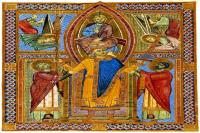
Feast day: 13 July
Henry was born in May 973 and was the son of Duke Henry II of Bavaria and Gisela of Burgundy. His father became an exile due to a quarrel with his cousin, the Emperor Otto II, and as a result Henry grew up in Hildesheim and was educated in the Christian faith by the Bishop of Regensberg. He then studied at Regensberg Cathedral. The Emperor ensured that Henry would get an ecclesiastical education, so that his involvement in church affairs would prevent him from participating in the Imperial Government. Otto II died, the elder Henry was released and having sworn allegiance to Otto’s heir he was restored as Duke of Bavaria. He died in 995 and the thirteen-year-old Henry was elected by the nobles to succeed his father.
In 999 he married Cunigunde of Luxembourg. The marriage gave him an extensive network of contacts through Germany’s western territories. In 1002,the young Emperor Otto III died leaving no heir and thus a disputed succession. Having failed to get the Archbishop of Cologne and the nobles to support him, Henry had himself crowned King of Germany (King of the Romans) by the Archbishop of Mainz in 1002. It was the first time a German king had not been crowned in Aachen Cathedral since Otto I began the tradition in 936. He managed to get the support of the Duke of Saxony and had his wife Cunigunde crowned Queen of Germany. He spent the next few years consolidating his position, travelling through his duchies to secure support since he had not been elected.
Italy had been under German control but the death of Otto III meant that it fell under the control of another claimant. Henry II, responding to a call from the Italian bishops, invaded Italy and after military successes was crowned king by the Archbishop of Milan. He rarely visited Italy after this, leaving it to govern itself.
Henry spent much of his reign defending his position as Emperor. He came into conflict with Poland, then a vassal of the empire, and with the Byzantine Empire which had claims on lands in Italy. He supported Pope Benedict VIII against the anti-pope and in return the Pope crowned Henry Holy Roman Emperor in St Peter’s basilica (The title Holy Roman Emperor was not in fact used till the thirteenth century but the concept was there earlier). He succeeded in persuading the Pope to add the term “filoque” to the Nicene Creed; that is, the Holy Spirit proceeds from the Father and the Son. This became one of the chief causes of the dispute between the Eastern and Western Churches that resulted in the schism of 1054.
As a ruler Henry was typical of other medieval monarchs in that he spent much of his reign at war. In general it seems he was generally merciful towards his enemies. It was in his dealings with the church that he gained his reputation for sanctitiy.
Henry had to resolve several ecclesiastical disputes inherited from his predecessor. In 1017 his wife Cunigunde became seriously ill and Henry promised to found a monastery if she recovered. When she did so in 1018, Henry ordered the construction of the Kaufungen Abbey. After his death the Empress retreated to the Abbey until her death in 1040.
Henry with his ecclesiastical education was always religious and supportive of the church. He promoted various monastic reforms. He strongly enforced clerical celibacy, partly because he did not want the public land he granted to clerics to be handed on to their heirs. He encouraged church reform, fostered missionary activity and made several charitable foundations for the poor. He was in fact so generous that his relatives complained that he was wasting the family fortune! He even wanted to become a monk but was commanded to continue as ruler of the Empire. He therefore continued to govern, convinced that this was a duty given him by God for the good of the people.
Henry appointed devout bishops who were loyal to him. He tended to give them temporal power at the expense of the nobles, whose positions were hereditary, and who were prone to rebellion.This policy led to the Emperor having control over the episcopacy and church appointments. This would lead to future conflict between the Empire and the Papacy. However, the church seems to have prospered during his reign.
In 994 St Odilo became Abbot of the famous Benedictine monastery of Cluny. Henry and he worked closely together to promote reform. Henry founded a monastery in Bamberg, Germany, which he made into a cathedral and new diocese. He worked to make this monastery the new Rome of Germany and to make its spiritual influence felt throughout the country.
He had a great love for his wife Cunigunde. Since they had no children it has been suggested that they took a vow of celibacy but this has been discounted by many historians. Cunigunde, who outlived him, was canonised in 1200.
In 1024 Henry became very ill with a painful infection and died in his palace at Gottingen. He was canonised in 1147. He and Cunigunde are buried in Bamberg cathedral; their tombs can still be seen today. They are one of the few married couples to have been made saints.
“Prayer seemed the chief delight and support of his soul; especially the public office of the church. Assisting one day at this holy function at Strasberg, he so earnestly desired to remain always there to sing the divine praises among the devout canons of the church, that finding this impossible, he founded there a new canonry for one who would always perform that sacred duty in his name.” (Butler's Lives of the Saints)
Saint Henry, pray for us.